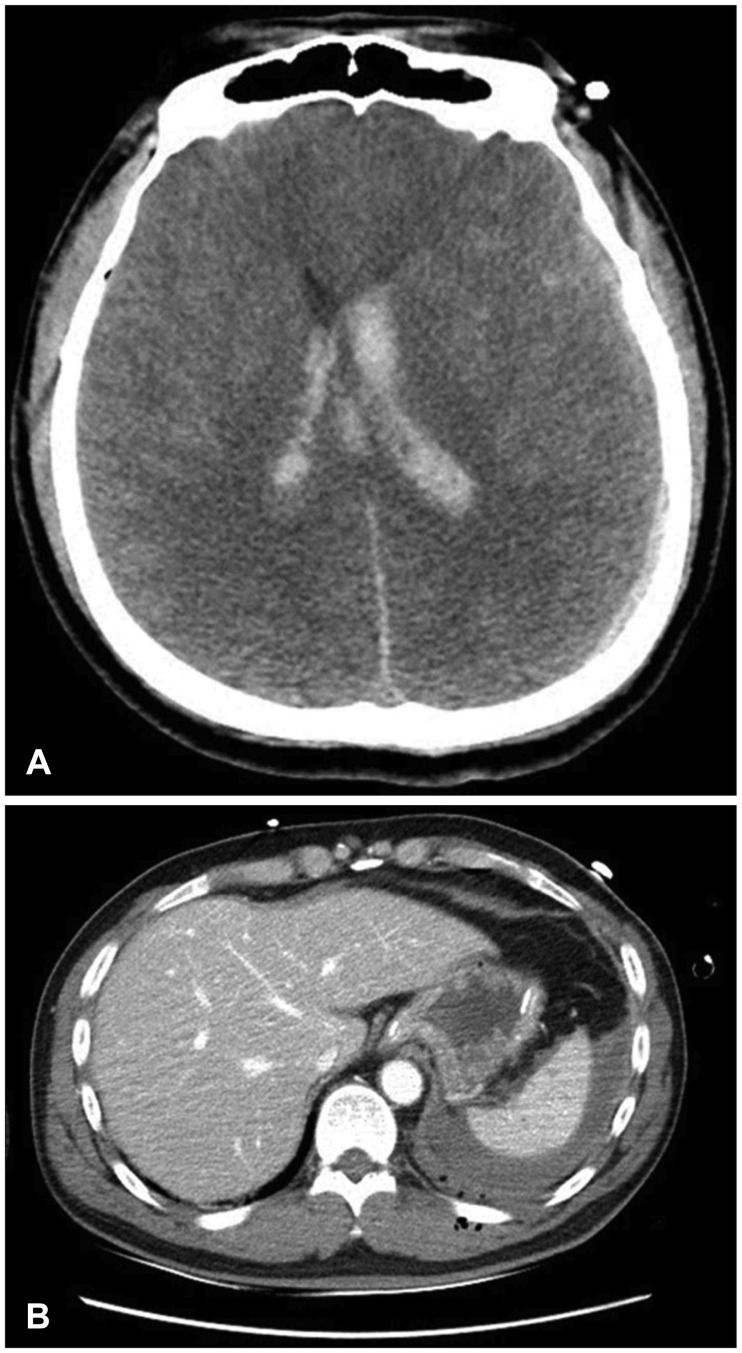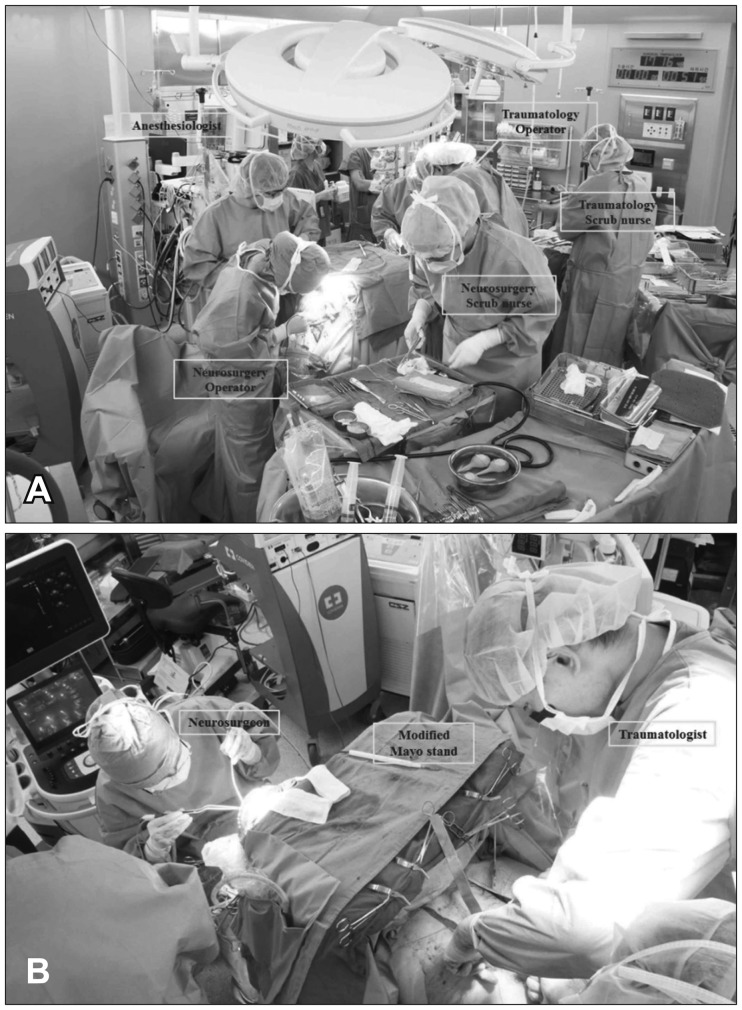Korean J Neurotrauma.
2017 Oct;13(2):141-143. 10.13004/kjnt.2017.13.2.141.
Concurrent Surgery of Craniectomy and Splenectomy as Initial Treatment in Severe Traumatic Head Injury: A Case Report
- Affiliations
-
- 1Department of Neurosurgery, Ajou University Hospital, Ajou University School of Medicine, Suwon, Korea. misshanyang80@gmail.com
- KMID: 2394549
- DOI: http://doi.org/10.13004/kjnt.2017.13.2.141
Abstract
- It is not a common case for neurosurgery department and the other departments to perform joint operation at the same time. Patients with severe head injury are a condition in which vital signs are unstable due to severe brain swelling and increased intracranial pressure, and emergency surgery is required. A 44-year-old man visited the trauma center with a motorcycle accident. The Glasgow Coma Scale score at the time of emergency department was 3 points, and the pupil was fixed at 6 mm on both sides. His medical history was unknown. His vital signs including blood pressure (BP), heart rate, respiratory rate and oxygen saturation were stable. Associated injuries included multiple fractures of whole body. Brain computed tomography revealed subarachnoid hemorrhage, intraventricular hemorrhage and severe cerebral edema. During the preparation of the craniectomy, abdominal ultrasonography performed because of decreased BP resulted in a large amount of hemoperitoneum. The bi-coronal craniectomy and splenectomy were performed simultaneously for about 4 hours. After fifty days of treatment, he was discharged with Glasgow Outcome Scale-extended 4 points and is undergoing rehabilitation. In severe polytrauma patients, active concurrent surgery is a good method to save their lives.
Keyword
MeSH Terms
-
Adult
Blood Pressure
Brain
Brain Edema
Craniocerebral Trauma*
Emergencies
Emergency Service, Hospital
Fractures, Multiple
Glasgow Coma Scale
Head*
Heart Rate
Hemoperitoneum
Hemorrhage
Humans
Intracranial Pressure
Joints
Methods
Motorcycles
Multiple Trauma
Neurosurgery
Oxygen
Pupil
Rehabilitation
Respiratory Rate
Splenectomy*
Subarachnoid Hemorrhage
Trauma Centers
Ultrasonography
Vital Signs
Oxygen
Figure
Reference
-
1. Alabbasi T, Nathens AB, Tien H. Blunt splenic injury and severe brain injury: a decision analysis and implications for care. Can J Surg. 2015; 58:S108–S117. PMID: 26100770.
Article2. Badjatia N, Carney N, Crocco TJ, Fallat ME, Hennes HM, Jagoda AS, et al. Guidelines for prehospital management of traumatic brain injury 2nd edition. Prehosp Emerg Care. 2008; 12(Suppl 1):S1–S52. PMID: 18203044.
Article3. Brasel KJ, DeLisle CM, Olson CJ, Borgstrom DC. Splenic injury: trends in evaluation and management. J Trauma. 1998; 44:283–286. PMID: 9498498.4. Clifton GL, Robertson CS, Kyper K, Taylor AA, Dhekne RD, Grossman RG. Cardiovascular response to severe head injury. J Neurosurg. 1983; 59:447–454. PMID: 6886758.
Article5. Goldschlager T, Steyn M, Loh V, Selvanathan S, Vonau M, Campbell S. Simultaneous craniotomy and caesarean section for trauma. J Trauma. 2009; 66:E50–E51. PMID: 19088560.
Article6. Hildebrand P, Roblick UJ, Schloricke E, Czymek R, Bruch HP, Bürk C. The role of organ preservation in the surgical therapy of traumatic spleen injury. Acta Chir Iugosl. 2011; 58:21–25.
Article7. Hörtnagl H, Hammerle AF, Hackl JM, Brücke T, Rumpl E, Hörtnagl H. The activity of the sympathetic nervous system following severe head injury. Intensive Care Med. 1980; 6:169–177. PMID: 7391345.
Article8. Leung LY, Wei G, Shear DA, Tortella FC. The acute effects of hemorrhagic shock on cerebral blood flow, brain tissue oxygen tension, and spreading depolarization following penetrating ballistic-like brain injury. J Neurotrauma. 2013; 30:1288–1298. PMID: 23461630.
Article9. Meguid AA, Bair HA, Howells GA, Bendick PJ, Kerr HH, Villalba MR. Prospective evaluation of criteria for the nonoperative management of blunt splenic trauma. Am Surg. 2003; 69:238–242. PMID: 12678481.10. Murray CJ, Lopez AD. Alternative projections of mortality and disability by cause 1990-2020: Global Burden of Disease Study. Lancet. 1997; 349:1498–1504. PMID: 9167458.
Article11. Obrist WD, Langfitt TW, Jaggi JL, Cruz J, Gennarelli TA. Cerebral blood flow and metabolism in comatose patients with acute head injury. Relationship to intracranial hypertension. J Neurosurg. 1984; 61:241–253. PMID: 6737048.12. Pachter HL, Guth AA, Hofstetter SR, Spencer FC. Changing patterns in the management of splenic trauma: the impact of nonoperative management. Ann Surg. 1998; 227:708–717. discussion 717-709. PMID: 9605662.13. Resende V, Petroianu A. Subtotal splenectomy for treatment of severe splenic injuries. J Trauma. 1998; 44:933–935. PMID: 9603106.
Article14. Rossaint R, Bouillon B, Cerny V, Coats TJ, Duranteau J, Fernández-Mondéjar E, et al. The European guideline on management of major bleeding and coagulopathy following trauma: fourth edition. Crit Care. 2016; 20:100. PMID: 27072503.
Article15. Sarrafzadeh AS, Peltonen EE, Kaisers U, Küchler I, Lanksch WR, Unterberg AW. Secondary insults in severe head injury-do multiply injured patients do worse? Crit Care Med. 2001; 29:1116–1123. PMID: 11395585.
Article16. Stocchetti N, Furlan A, Volta F. Hypoxemia and arterial hypotension at the accident scene in head injury. J Trauma. 1996; 40:764–767. PMID: 8614077.
Article17. Traub A, Giebink GS, Smith C, Kuni CC, Brekke ML, Edlund D, et al. Splenic reticuloendothelial function after splenectomy, spleen repair, and spleen autotransplantation. N Engl J Med. 1987; 317:1559–1564. PMID: 3120008.
Article18. Velanovich V. Blunt splenic injury in adults: a decision analysis comparing options for treatment. Eur J Surg. 1995; 161:463–470. PMID: 7488658.19. Watson GA, Rosengart MR, Zenati MS, Tsung A, Forsythe RM, Peitzman AB, et al. Nonoperative management of severe blunt splenic injury: are we getting better? J Trauma. 2006; 61:1113–1118. PMID: 17099516.
Article20. Wilmore DW, Long JM, Mason AD Jr, Skreen RW, Pruitt BA Jr. Catecholamines: mediator of the hypermetabolic response to thermal injury. Ann Surg. 1974; 180:653–669. PMID: 4412350.
- Full Text Links
- Actions
-
Cited
- CITED
-
- Close
- Share
- Similar articles
-
- Laparoscopic Splenectomy in a Case of Stable Blunt Abdominal Trauma
- Decompressive Craniectomy in Traumatic Brain Injury: A Review Article
- Early Preventive Decompressive Craniectomy in Patients with Severe Traumatic Brain Injury
- Postoperative Contralateral Hematoma in Patient with Acute Traumatic Brain Injury
- Outcomes of Ultra-Early Decompressive Craniectomy after Severe Traumatic Brain Injury-Treatment Outcomes after Severe TBI



